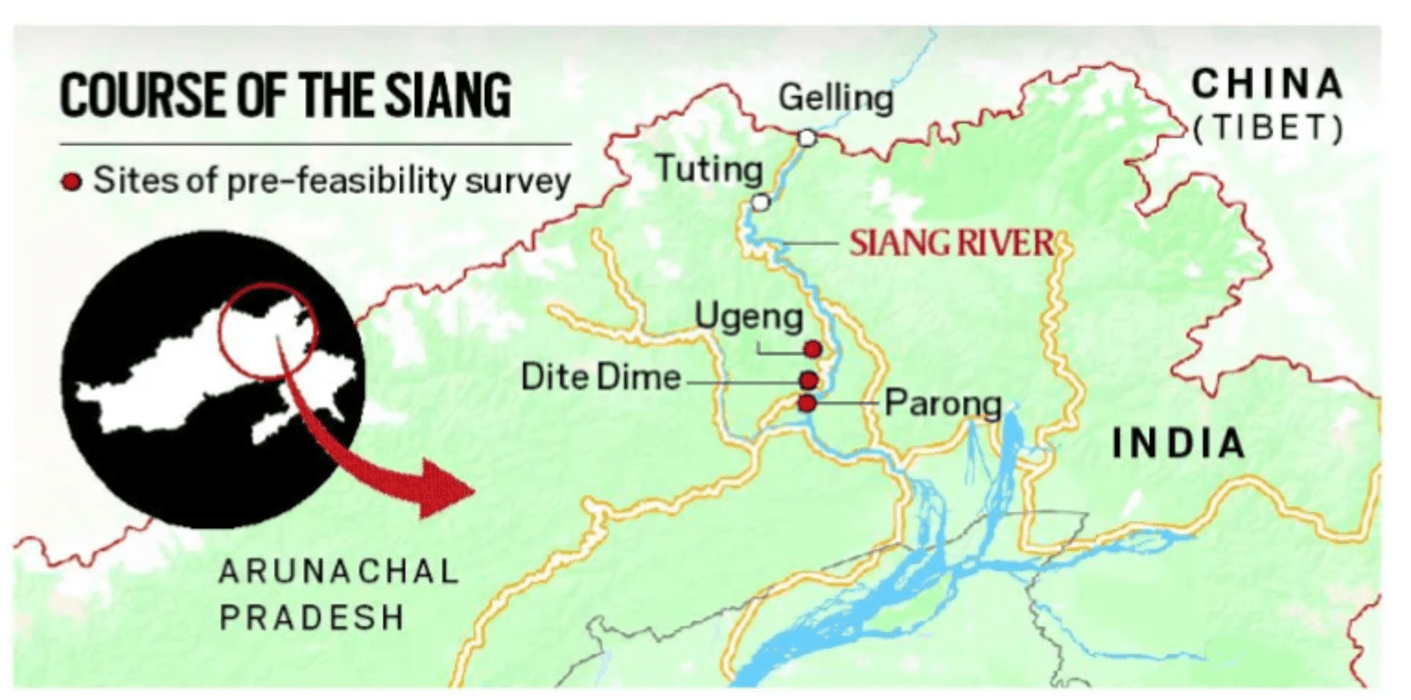News Excerpt:
Locals are protesting against the mega dam project in Arunachal Pradesh on Upper Siang River.

More about the project:
- The Upper Siang Multipurpose Storage Project is an ambitious hydropower initiative proposed in the Upper Siang district of Arunachal Pradesh.
- This project aims to harness the potential of the Siang River, known as the Tsangpo in Tibet, which originates near Mount Kailash and traverses over 1,000 km before entering Arunachal Pradesh and eventually becoming the Brahmaputra in Assam.
- The proposed project, with a capacity of 11,000 megawatts, replaces the earlier planned Siang Upper Stage-I and Stage-II projects and is set to be the largest dam in the subcontinent at 300 metres height.
- The National Hydroelectric Power Corporation (NHPC) is responsible for constructing this mega dam.
Significance of the Project:
- The Upper Siang project is not only significant for its hydropower potential but also for its strategic importance.
- India views this project as a countermeasure to China's hydropower activities on the Tsangpo, especially considering China's plan for a 60,000 MW super dam in Tibet's Medog county.
- This super dam is expected to divert water to China's arid northern regions, potentially reducing the flow into India.
- The Upper Siang dam would act as a reservoir to mitigate the impacts of this reduced flow, ensuring water security for the region.
Environmental and Social Concerns:
- Despite its strategic and hydropower potential, the Upper Siang project faces significant opposition from local communities and activists.
- The Siang Indigenous Farmers Forum (SIFF), Dibang Resistance, and North East Human Rights have raised concerns about the project's environmental and social impact.
- The memorandum prepared by these groups highlights the threat to delicate ecosystems, wildlife habitats, and biodiversity in the region.
- The project is expected to submerge more than 300 villages, displacing the Adi tribe and affecting their ancestral lands and cultural practices.
- Local activists emphasise that Arunachal Pradesh already hosts numerous dams, and the proposed mega dam would further burden the region's rivers.
- Gegong Jijong, an SIFF activist, points out the difficulties that displaced communities would face, including the loss of farming and gardens, which are vital for their survival.
- The potential displacement raises concerns about the sustainability of their traditional way of life.
Renewed Push and Resistance
- Despite assurances from Arunachal Pradesh Chief Minister that the project would proceed only with the people's consent, authorities have accelerated pre-construction activities, heightening tensions among local communities.
- The NHPC has initiated a pre-feasibility survey, selecting three sites along the Siang River for feasibility studies.
- Additionally, the NHPC has sanctioned a Rs 325 crore CSR package to support livelihood schemes and infrastructure development in health, education, and sports.
- Local authorities are conducting a massive public outreach campaign to garner support for the project, framing it as a matter of national interest.
- However, activists remain sceptical, particularly given the recent Forest (Conservation) Amendment Act, which exempts strategic projects within 100 km of India's borders from clearance requirements.
- Activists argue that portraying the Upper Siang dam as a project of national security relevance is problematic, especially considering the region's history of anti-dam resistance.
Way Forward:
- Ensure local community involvement through transparent consultations and participatory planning.
- Develop fair compensation and livelihood restoration plans for displaced communities while using the CSR package effectively for health, education, and infrastructure improvements, and invest in sustainable development projects for long-term benefits.
- Conduct thorough environmental and social impact assessments, establish independent monitoring bodies and implement advanced water management systems.
- Balance the project's strategic importance with local concerns, advocating for policy reforms that protect indigenous rights and environmental sustainability.


